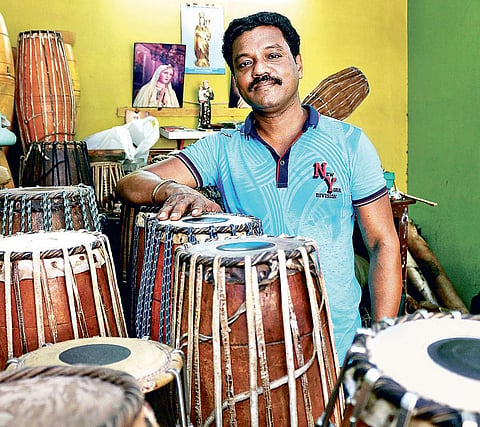

CHENNAI: It’s no secret that Mylapore is the cultural hub of the city. It is also a hub of mridangam repairers and manufacturers, who are scattered in pockets of this neighbourhood. What’s even more interesting is that they all belong to the same family, pursuing this as a traditional business for many generations. A Arogyam, a sixth-generation repairer, comes from Thanjavur, the land of instrument makers.
His grandfather’s family moved to Chennai and settled here about 100 years back, considering the better prospects thanks to the dynamic Carnatic scene in the city. “I started my own shop in 2004. My cousins and all the relatives are taking care of their respective shops across Mylapore. We’ve loyal customers who have been coming to us for generations. I believe that you don’t need knowledge in music to create these instruments. Of course, they aid the process but experience, observation and concentration can help learn the skill and master the art,” says Arogyam, who learned this job from his uncle when he was 10 years old.
As you step into his small shop, you’ll find mridangams of all sizes and colours assembled in all corners, leaving little space to walk around. He tells us that till date kokki, knife and kuthoosi (a sharp tool for piercing holes) are the main self-made tools used by the workers. The raw materials that form the base of the instrument are made of cow, buffalo or goatskin. It is washed, stretched and dried for weeks once they’re brought from the market. Then, they are soaked in tubs of water, which makes the skin soft and is easy to use. The process is easier during summer because the skin dries fast and it decides the longevity of the instrument.
Getting the thalam right
The shop houses over 250 mridangams. Each one weighs anywhere between six to nine kilos. It takes four to seven days to make one mridangam. The barrel-shaped body is made of wood sourced from a jackfruit tree or konna maram (golden rain tree). Jackfruit is the most preferred for achieving a vibrant sound.
“Can you believe that every skin texture produces a different shruti? That’s the beauty of this instrument. The skin is sourced from Vyasarpadi. Among the lot, cow skin is considered the most expensive. The tricks of the trade have been passed on to us by our ancestors. Nobody else can handle the stench of this skin,” he shares. This vigorous process requires an equal effort of the artisans’ arms and legs to get the right tension of the instrument.
There are two heads to the barrel body. The right head with a black spot is called mettu. It is made using kittangal (a stone) along with cooked rice. This part determines the tonal quality. The bigger the diametre of the black spot, the louder it sounds. The left head gives the bass sound. The right head is a combination of all three skins. “The sound coming from mridangam might be the same, but shruti and tone patterns differ from person to person. Once we pick up their hand movement, tempo and listen to them play, we will know what kind of mridangam will suit their taste. Tuning the instrument to shruti is the toughest part. The whole instrument goes waste if this perfection is not achieved,” he says, pointing towards a 100-year-old mridangam.
Heavily bound by leather, the lifespan of a good mridangam is considered to be long depending on the usage and maintenance. However, the challenging part of the making is binding the two heads to the sides of the body using leather. The leather straps have to be perfectly intertwined and inserted into the holes along the edge of the head to be connected to the body. The process is called mootu pirikiradhu.
God’s own instrument
Some of Arogyam’s patrons include senior artistes like TV Gopalakrishnan, Mannargudi Easwaran and R Sankaranarayanan. All of them want the shop to be close by so that repairs can be undertaken anytime. Arogyam also has customers from Kumbakonam, Thanjavur, Mysuru, and Bengaluru. There is an active clientele from foreign countries like Singapore, London, and Mauritius. He keeps travelling every three months to different places. “Margazhi is the peak season during which most of the teachers along with their students fly down to India. They come to our shop, explain their requirements, and get it repaired before going back. Otherwise, we’re busy most of the time. Young students, dancers, bhajan singers and teachers keep us occupied throughout the year. In other cases, I export these instruments in bulk.
We make sure that they are light-weight and neatly packed in cardboard boxes to ensure safety,” he explains. Arogyam’s son Abish Antony is prepping to be the seventh-generation repairer, ready to take the legacy forward. Abish learned to play the instrument for two years. Leaning more towards repair work, he discontinued his education and helps his father along with four other artisans. “I’ve always respected traditional instruments.
Of course, I know certain theoretical aspects and play it for people so that they can make their best pick based on the sound quality. Technology can upgrade any instrument and electric versions can be made. But mridangam is divine and special. It’s called the god’s own instrument along with the veena and tambura. However, the number of repairers has gone down and I want to keep this art alive,” says Abish.